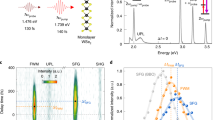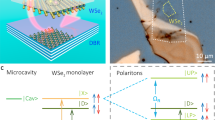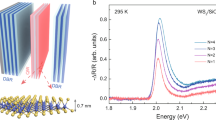Abstract
A hallmark of wave–matter duality is the emergence of quantum-interference phenomena when an electronic transition follows different trajectories. This type of interference results in asymmetric absorption lines such as Fano resonances1, and gives rise to secondary effects such as electromagnetically induced transparency when multiple optical transitions are pumped2,3,4,5. Few solid-state systems show quantum interference and electromagnetically induced transparency5,6,7,8,9,10,11, with quantum-well intersubband transitions in the infrared region12,13 offering the most promising avenue to date to devices exploiting optical gain without inversion14,15. Quantum interference is usually hampered by inhomogeneous broadening of electronic transitions, making it challenging to achieve in solids at visible wavelengths and elevated temperatures. However, disorder effects can be mitigated by raising the oscillator strength of atom-like electronic transitions—excitons—that arise in monolayers of transition-metal dichalcogenides16,17. Quantum interference, probed by second-harmonic generation18,19, emerges in monolayer WSe2, without a cavity, to split the frequency-doubled laser spectrum. The splitting exhibits spectral anticrossing behaviour, and is related to the number of Rabi flops the strongly driven system undergoes. The second-harmonic generation power-law exponent deviates strongly from the canonical value of 2, showing a Fano-like wavelength dependence that is retained at room temperature. The work opens opportunities in solid-state quantum-nonlinear optics for optical mixing, gain without inversion and quantum-information processing.
This is a preview of subscription content, access via your institution
Access options
Access Nature and 54 other Nature Portfolio journals
Get Nature+, our best-value online-access subscription
$29.99 / 30 days
cancel any time
Subscribe to this journal
Receive 12 print issues and online access
$209.00 per year
only $17.42 per issue
Buy this article
- Purchase on Springer Link
- Instant access to full article PDF
Prices may be subject to local taxes which are calculated during checkout




Similar content being viewed by others
Data availability
The data that support the plots within this paper and other findings of this study are available from the corresponding authors upon reasonable request.
References
Fano, U. Effects of configuration interaction on intensities and phase shifts. Phys. Rev. 124, 1866–1878 (1961).
Harris, S. E., Field, J. E. & Imamoğlu, A. Nonlinear optical processes using electromagnetically induced transparency. Phys. Rev. Lett. 64, 1107–1110 (1990).
Harris, S. E. Electromagnetically induced transparency. Phys. Today 50, 36–42 (1997).
Lukin, M. D. & Imamoğlu, A. Controlling photons using electromagnetically induced transparency. Nature 413, 273–276 (2001).
Fleischhauer, M., Imamoglu, A. & Marangos, J. P. Electromagnetically induced transparency: optics in coherent media. Rev. Mod. Phys. 77, 633–673 (2005).
Ham, B. S., Hemmer, P. R. & Shahriar, M. S. Efficient electromagnetically induced transparency in a rare-earth doped crystal. Opt. Commun. 144, 227–230 (1997).
Wei, C. & Manson, N. B. Observation of the dynamic Stark effect on electromagnetically induced transparency. Phys. Rev. A 60, 2540–2546 (1999).
Turukhin, A. V. et al. Observation of ultraslow and stored light pulses in a solid. Phys. Rev. Lett. 88, 023602 (2001).
Phillips, M. C. et al. Electromagnetically induced transparency in semiconductors via biexciton coherence. Phys. Rev. Lett. 91, 183602 (2003).
Longdell, J. J., Fraval, E., Sellars, M. J. & Manson, N. B. Stopped light with storage times greater than one second using electromagnetically induced transparency in a solid. Phys. Rev. Lett. 95, 063601 (2005).
Abdumalikov, A. A. et al. Electromagnetically induced transparency on a single artificial atom. Phys. Rev. Lett. 104, 193601 (2010).
Faist, J., Capasso, F., Sirtori, C., West, K. W. & Pfeiffer, L. N. Controlling the sign of quantum interference by tunnelling from quantum wells. Nature 390, 589–591 (1997).
Serapiglia, G. B., Paspalakis, E., Sirtori, C., Vodopyanov, K. L. & Phillips, C. C. Laser-induced quantum coherence in a semiconductor quantum well. Phys. Rev. Lett. 84, 1019–1022 (2000).
Scully, M. O. & Fleischhauer, M. Lasers without inversion. Science 263, 337–338 (1994).
Frogley, M. D., Dynes, J. F., Beck, M., Faist, J. & Phillips, C. C. Gain without inversion in semiconductor nanostructures. Nat. Mater. 5, 175–178 (2006).
Chernikov, A. et al. Exciton binding energy and nonhydrogenic Rydberg series in monolayer WS2. Phys. Rev. Lett. 113, 076802 (2014).
He, K. et al. Tightly bound excitons in monolayer WSe2. Phys. Rev. Lett. 113, 026803 (2014).
Seyler, K. L. et al. Electrical control of second-harmonic generation in a WSe2 monolayer transistor. Nat. Nanotech. 10, 407–411 (2015).
Wang, G. et al. Giant enhancement of the optical second-harmonic emission of WSe2 monolayers by laser excitation at exciton resonances. Phys. Rev. Lett. 114, 097403 (2015).
Manca, M. et al. Enabling valley selective exciton scattering in monolayer WSe2 through upconversion. Nat. Commun. 8, 14927 (2017).
Claassen, M., Jia, C., Moritz, B. & Devereaux, T. P. All-optical materials design of chiral edge modes in transition-metal dichalcogenides. Nat. Commun. 7, 13074 (2016).
Kroner, M. et al. The nonlinear Fano effect. Nature 451, 311–314 (2008).
Cadiz, F. et al. Excitonic linewidth approaching the homogeneous limit in MoS2-based van der Waals heterostructures. Phys. Rev. X 7, 021026 (2017).
Sun, D. et al. Observation of rapid exciton–exciton annihilation in monolayer molybdenum disulfide. Nano Lett. 14, 5625–5629 (2014).
Chernikov, A., Ruppert, C., Hill, H. M., Rigosi, A. F. & Heinz, T. F. Population inversion and giant bandgap renormalization in atomically thin WS2 layers. Nat. Photon. 9, 466–470 (2015).
Sun, Y. et al. 946 nm Nd:YAG double Q-switched laser based on monolayer WSe2 saturable absorber. Opt. Express 25, 21037–21048 (2017).
Moody, G. et al. Intrinsic homogeneous linewidth and broadening mechanisms of excitons in monolayer transition metal dichalcogenides. Nat. Commun. 6, 8315 (2015).
Xu, X., Yao, W., Xiao, D. & Heinz, T. F. Spin and pseudospins in layered transition metal dichalcogenides. Nat. Phys. 10, 343–350 (2014).
Limonov, M. F., Rybin, M. V., Poddubny, A. N. & Kivshar, Y. S. Fano resonances in photonics. Nat. Photon. 11, 543–554 (2017).
Castellanos-Gomez, A. et al. Deterministic transfer of two-dimensional materials by all-dry viscoelastic stamping. 2D Mater. 1, 011002 (2014).
Acknowledgements
The authors thank A. Chernikov, R. Huber, T. Korn, F. Langer, P. Nagler, A. Kormányos and B. Ren for helpful discussions, S. Krug for technical support, and R. Martin for assistance with sample preparation. Financial support is gratefully acknowledged from the German Science Foundation through SFB 1277 project B03.
Author information
Authors and Affiliations
Contributions
K.-Q.L. conceived and performed the experiments with the support of S.B. S.B. wrote the simulation codes and carried out simulations with K.-Q.L. K.-Q.L., S.B. and J.M.L. analysed the data and wrote the paper.
Corresponding authors
Ethics declarations
Competing interests
The authors declare no competing interests.
Additional information
Publisher’s note: Springer Nature remains neutral with regard to jurisdictional claims in published maps and institutional affiliations.
Supplementary information
Supplementary Information
2 Chapters, 17 Figures, 11 References
Rights and permissions
About this article
Cite this article
Lin, KQ., Bange, S. & Lupton, J.M. Quantum interference in second-harmonic generation from monolayer WSe2. Nat. Phys. 15, 242–246 (2019). https://doi.org/10.1038/s41567-018-0384-5
Received:
Accepted:
Published:
Issue Date:
DOI: https://doi.org/10.1038/s41567-018-0384-5
This article is cited by
-
Excitons stabilize above the band gap in bilayer WSe2
Nature Nanotechnology (2024)
-
Nonlinear optics of two-dimensional heterostructures
Frontiers of Physics (2024)
-
Quantum interference between dark-excitons and zone-edged acoustic phonons in few-layer WS2
Nature Communications (2023)
-
Giant second-harmonic generation in ferroelectric NbOI2
Nature Photonics (2022)
-
Excitonic resonances control the temporal dynamics of nonlinear optical wave mixing in monolayer semiconductors
Nature Photonics (2022)



